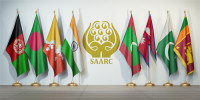Opinion
Friends in high places
Five South Asian countries come together to conserve shrinking mountain glaciers
Autumn in Nepal heralds the end of the muddy monsoon season. Clearer skies bring better views of the snow-clad Himalaya, ready for nature enthusiasts and trekkers from all over the world. But these days, the white mountains are grey, and it looks like the Himalaya has stopped smiling. Sad as it may be, the sorry state of our mountains brings welcome attention to the rapid pace of glacier and snow melting caused by climate change and pollution around the world.
In Nepal and other mountain nations across South Asia, these threats to our environment carry a growing sense of urgency. By all accounts, more than 25,000 glaciers in the Hindu Kush Himalaya region, which spans eight countries from Afghanistan to Myanmar, are retreating fast. During the past century, most of the Himalayan glaciers have been shrinking and, between 2003 and 2009, lost an estimated 174 gigatonnes of water each year at a rate faster than the global average. Worse, projections of climate change for the region suggest that rising temperatures will further impact snowmelt.
In addition to climate change, soot—or black carbon—emitted in part by industry, motor vehicles, coal-fired power plants and firewood used for cooking and heating is a significant contributor to glacial melting in South Asia. By darkening snow and ice covers, black carbon decreases the reflecting power of glaciers—raising air temperatures and accelerating further glacier melting.
Why does that matter to Nepalis and their South Asian neighbours? Simply put, if we do not act promptly, we are likely to face higher biodiversity losses, lower economic growth, and more acute food and water shortages in the future. The mountains of the Hindu Kush Himalaya hold more of the earth’s snow and ice than anywhere beyond the poles, and store 10 percent of all freshwater.
By feeding 10 large Asian rivers systems, the mountain glaciers serve as a vital source of energy and provide water for irrigation and private use for millions of people living downstream. More than 210 million people living within the Indus, Ganges and Brahmaputra basins alone depend on the water resources provided by the Hindu Kush Himalaya for their drinking water, irrigation and hydropower.
In Nepal, the livelihoods of people are markedly affected by climate variations. Recent estimates indicate that climate change impacts will depress Nepal’s Gross Domestic Product up to 2 percent a year. As extreme weather events intensify, this number could reach 5 percent. It’s obvious that climate change and atmospheric pollution know no boundaries, affecting livelihoods, economies and ecosystems across South Asia. And less developed mountainous countries like Nepal cannot address these adverse impacts on their own.
Despite standing as one of the world’s largest glaciated areas, South Asian countries have yet to come together to address the enormous—and common—challenges caused by their melting glaciers. Case in point: A recent study noted that mass balancing, the only effective technique to measure ice variations in glaciers—and thus a valuable indicator of their health—has been completed in only 10 of the region’s more than 50,000 glaciers.
Why? We still don’t have suitable mechanisms in place to share data and generate new knowledge, and most long-term data on glaciers is absent from the public domain. To help with that, we should encourage official meteorological departments across the South Asia region to share their climate research. Thankfully, South Asian countries are becoming more aware that their glaciers and majestic mountain range represent a precious common heritage, and an opportunity to develop a sustainable green economy.
And while our mountains are difficult terrain, they are rich in natural resources. One of these is mostly untapped hydropower, which can provide a significant renewable energy source that can reduce our dependence on fossil fuels, boost South Asia’s economies, and bring greater prosperity to its people. Another area with great potential is tourism. The Hindu Kush Himalaya’s unique biodiversity and spectacular natural assets can generate revenue from eco-tourism and provide a sustainable livelihood to people across the region. To achieve that, we mountainous countries need to learn from each other across boundaries to maintain our ecological integrity and realise the promise of our mountain economies.
As such, the launch in Kathmandu this week of the Hindu Kush Himalaya Glaciers and Mountain Economy Network is a step in the right direction. Together with scientists and climate champions, delegates from five South Asian countries—including Afghanistan, Bhutan, India, Nepal and Pakistan—agreed to join forces to fight climate change and pollution, and promote a sustainable future for their people and economies.
Lifted by our collective wisdom and shared knowledge, this initiative marks a critical start towards protecting our glacier heritage and fostering a vibrant mountain economy. This commitment is welcome news as time is ticking away for our melting glaciers, and we must act now to preserve their unique legacy.
Mani is a lead economist in the Office of the Chief Economist of the World Bank’s South Asia Region.




 20.12°C Kathmandu
20.12°C Kathmandu









